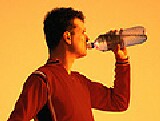
MONDAY, June 30, 2014 (HealthDay News) — Local weather affects Americans’ levels of exercise and their risk for obesity, a new study suggests.
Researchers found that adults in counties with hot summers are less physically active and more likely to be obese, especially if the summers are also humid or rainy.
Adults also get less exercise and are more likely to be obese in counties where winters are especially cold, according to the researchers at the University of Texas at Austin.
They said their findings — published in the July issue of the American Journal of Public Health — help explain why people in certain regions of the United States are more likely to be obese than those in other areas.
Many of the counties where exercise levels are lowest and obesity rates highest are in the Southeast, where summers are hot and wet, and many of the counties with the highest levels of exercise and the lowest obesity rates are in the mountain West, where summers are cool and dry, the researchers noted.
“Living in Texas as I do, the results really resonated for me,” study co-author Paul von Hippel, an assistant professor in the School of Public Affairs, said in a university news release.
“Around June or July here, it starts getting hard to think about going outside for a jog — or even a brisk walk — after work, which is close to the hottest part of the day. You have to come up with a strategy for staying active in the summer. Are you going to get out in the early morning, which is the coolest part of the day? Are you going to swim? Or are you going to do something indoors, like basketball or ice skating or just walking on a treadmill?”
City planners and developers who want to encourage physical activity need to take local weather into account.
“Some planners are more thoughtful about that than others,” von Hippel said. “A great example of thoughtful planning is the hike-and-bike trail along Lady Bird Lake in Austin, Tex. It’s shady, it’s next to water and it attracts thousands of walkers, runners and bikers on the hottest summer days.”
The impact of local weather on obesity remained even after the researchers controlled for other factors, such as urban sprawl, population characteristics, parks, stores and restaurants.
“In a sense, the importance of weather is obvious, but we looked at some other ‘obvious’ things, and they didn’t pan out,” von Hippel said.
“For example, going in we knew that Coloradans were exceptionally thin and active, so we expected to find that hills and mountains encourage physical activity. But it turns out that terrain matters very little for activity or obesity. In some mountainous areas, like Colorado, people are very active, but in others, such as West Virginia, they aren’t.”
More information
The U.S. Centers for Disease Control and Prevention has more about physical activity.
Copyright © 2025 HealthDay. All rights reserved.

